Prologue
In one of our earlier blog posts we demonstrated our synthetic data platform using a well studied, publicly available dataset of over 50’000 historic diamond sales with 10 recorded data points each. It served as an educational example to introduce the idea of synthetic data, as well as to showcase the unparalleled accuracy of our technology. With the click of a button, users of our platform can forge an unlimited number of precious, highly realistic, highly representative synthetic data diamonds.
But, to be fair, the example didn’t do justice to the type and scale of real-world behavioral data assets encountered in today’s industry, whether it’s financial, telecommunication, healthcare or other digital services. Organizations operate at a different order of magnitude, as they serve millions of customers and record thousands of data points over time for each one of those. Whether these recorded sequences of events represent transactions, visits, clicks or other actions, it is so important that these rich behavioral stories of customers are understood, analyzed, and leveraged at scale in order to provide smarter services with the best possible user experience for each customer.
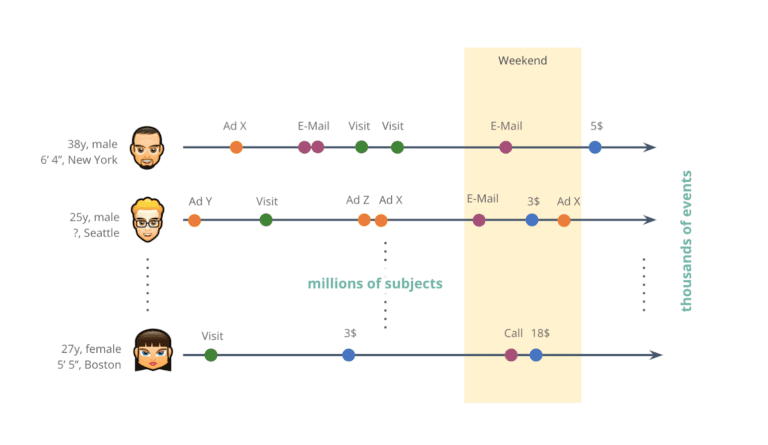
Today, organizations collect thousands of events for each and every one of their millions of customers.
But despite the immense growth in volume over recent years, the captured behavioral data still remains vastly an untapped opportunity. And over and over again, we can identify two key obstacles at organizations at play:
1) Behavioral data is primarily sequential and constantly evolving, rather than static and fixed – and with its thousands of data points per individual, there is a sheer unlimited number of potential temporal inter-dependencies and contextual correlations to look for. To say it simply: It’s a fundamentally different category beast than what is being taught at Statistics 101. Existing business intelligence tools, as well as regression or tree-based models struggle in making sense of this type of data at scale. Thus it is no surprise that only the most data-savvy organizations turn up on the winning side by knowing how to leverage their immense behavioral data assets to effectively gain a competitive edge with hyper-personalized customer experiences.
2) The second obstacle is, that behavioral data remains primarily locked up. Because with thousands of available data points per customer the re-identification of individual subjects becomes increasingly easy. Existing anonymization techniques (e.g. data masking), that have been developed to work for a handful of sensitive attributes per subject, stand no chance in protecting privacy while retaining the utility of this type of data at a granular level. A disillusion that is by now also broadly understood and recognized by the public:

As it turns out, these are two reinforcing effects: Without safe data sharing, you can’t establish data literacy around behavioral data. Without data literacy, you will not see the growing demand for behavioral data in your organization. However, only some companies will remain stuck in their inertia, while others are able to identify and thus address the dilemma by turning towards synthetic data, which allows them to offer smart, adaptive, and data-driven services to win the hearts of the consumers (as well as the markets).
The Curse of Dimensionality
Let’s look at an example to illustrate the complexity of sequential behavioral data. Within retail banking, each account will have a sequence of transactions recorded. But even if we discard any personally identifiable information on the customer, and even if we limit the amount of information per transaction to 5 distinct transaction amounts, and 20 distinct transaction categories, the number of behavioral stories quickly explodes with the length of the sequences. While a single transaction seems innocuous with its 20*50 = 100 possible outcomes, two transactions will already yield 100*100 = 10’000 outcomes. For a sequence of three transactions we are at 100^3 = 1 million outcomes per customer, and at forty recorded transactions, we will already have more possible outcomes (10^80) than atoms in the universe! No wonder, that these digital traces are highly identifying, and near impossible to obfuscate. No wonder, that making sense of this vast sea of data and detecting patterns and nuances therein poses such a huge challenge.
This combinatorial explosion, the exponential growth of outcomes with the number of records per subject, is also referred to as the curse of dimensionality. There is no person like another, everyone is different, everyone is unique. It’s a curse for analytics, it’s a curse for protecting privacy. But, at the same time, it’s a blessing for customer-centric organizations, who are willed to embrace a rich, diverse world of individuals, and who recognize this to be an opportunity to differentiate on top of these otherwise hidden behavioral patterns.

AI-Generated Synthetic Data to the Rescue
The power of synthetic data continues to be recognized as THE way forward for privacy-preserving data sharing. While there are various approaches and levels of sophistication, ranging from simple rule-based to more advanced model-based generators, our focus at MOSTLY AI has always been on offering the world’s most accurate solution based on deep neural network architectures. These are high-capacity, state-of-the-art machine learning models, that can reliably and automatically pick up and retain complex hidden patterns at scale. In particular for the type of sequential data, that is so prevalent among an organization’s behavioral data assets. These models make little a-prior assumptions and require no manual feature engineering by domain experts. They are the very same models that have revolutionized so many fields already over the past couple of years, like image classification, speech recognition, text translation, robotics, etc., that are now about to change privacy-preserving big data sharing once and for all.
And ultimately, it is the accuracy and representativeness of the synthetic data that is the key driver of its value. This is what will determine whether use cases go beyond mere testing & development, and expand towards advanced analytics and machine learning tasks as well, where synthetic data can be relied on in lieu of the actual privacy-sensitive customer data. And just as classic learning algorithms continue to be superseded by deep learning in the presence of big data, one can already observe a similar evolution for the market of synthetic data solutions for behavioral data assets.
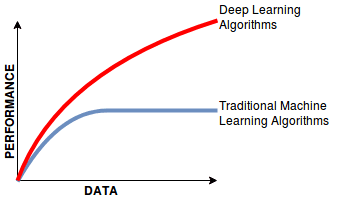
This was the first part of our mini-series on sequential data, setting the stage for next week’s post. There we will present a handful of empirical case studies to showcase the power of our synthetic data platform, in particular with respect to the important domain of behavioral data – so make sure that you don’t miss out on it!
Credits: This work is supported by the "ICT of the Future” funding programme of the Austrian Federal Ministry for Climate Action, Environment, Energy, Mobility, Innovation and Technology.
It’s 2020, and I’m reading a 10-year-old report by the Electronic Frontier Foundation about location privacy that is more relevant than ever. Seeing how prevalent the bulk collection of location data would become, the authors discussed the possible threats to our privacy as well as solutions that would limit this unrestricted collection while still allowing to reap the benefits of GPS enabled devices.
Some may have the opinion that companies and governments should stop collecting sensitive and personal information altogether. But that is unlikely to happen and a lot of data is already in the system, changing hands, getting processed, and analyzed over and over again. This can be quite unnerving but most of us do enjoy the benefits of this information sharing like receiving tips on short-cuts through the city during the morning rush hour. So how can we protect the individual’s rights and make responsible use of location data?
Until very recently, the main approach was to anonymize these data sets: hide rare features, add noise, aggregate exact locations into rough regions or publish only summary statistics (for a great technical but still accessible overview, I can recommend this survey). Cryptography also offers tools to keep most of the sensitive information on-device and only transmit codes that compress use-case relevant information. However, these techniques make a big trade-off between privacy, accuracy, and utility of the modified data. Even after this preprocessing, if the original data retains any of its utility then the risk of successfully re-identifying an individual is extremely high.
D.N.A. is probably the only thing that’s harder to anonymize than precise geolocation information.
Time and again, we see how subpar anonymization can lead to high-profile privacy leaks and this is not surprising, especially for mobility data: in a paper published in Scientific Reports, researchers showed that 95% of the population can be uniquely identified just from four time-location points in a data set with hourly records and spatial resolution given by the carrier’s antenna. In 2014, the publication of supposedly safe pseudonymized taxi trips allowed data scientists to find where celebrities like Bradley Cooper or Jessica Alba were heading by querying the data based on publicly available photos. Last year, a series of articles in the New York Times highlighted this issue again: from a data set with anonymized user IDs, the journalists captured the homes and movements of US government officials and easily re-identified and tracked even the president.
Mostly AI’s solution for privacy-preserving data publishing is to go synthetic. We develop AI-based methods for modeling complex data sets and then generate statistically representative artificial records. The synthetic data contains only made-up individuals and can be used for test and development, analysis, AI training, or any downstream tasks really. Below, I will explain this process and showcase our work on a real-world mobility data set.
The Difficulties With Mobility Data
What is a mobility data set in the first place? In its simplest form, we might be talking about single locations only where a record is a pair of latitude and longitude coordinates. In most situations though, we have trips or trajectories which are sequences of locations.

The trips are often tagged by a user ID and the records can include timestamps, device information, and various use-case specific attributes.
The aim of our new Mobility Engine is to capture and reproduce the intricate relationship between these attributes. But there are numerous issues that make mobility data hard to model.
- Sparsity: a fixed latitude/longitude pair from the data set appears once or a few times, especially at high granularity records.
- Noise: GPS recordings can include a fair amount of noise so even people traveling the exact same route can have quite different trajectories recorded.
- Different scales: the same data set could include pedestrians walking in a park and people taking cabs from the airport to the city so the change in data points can vary highly.
- Sampling rate: making modeling even more difficult, even short trips can contain hundreds of recordings and long trips might sample very infrequently.
- Size of the data set: the most useful data sets are often the largest. Any viable modeling solution should handle millions of trips with a reasonable turn-over.
Our solution can overcome all these difficulties without the need to compromise on accuracy, privacy or utility. Let me demonstrate.
Generating Synthetic Trajectories
The Porto Taxi data set is a public collection of a year’s worth of trips by 442 cabs running in the city of Porto, Portugal. The records are trips, sequences of latitude/longitude coordinates recorded at 15-second intervals, with some additional metadata (such as driver ID or time of day) that we won’t consider now. There are short and long trips alike and some of the trajectories are missing a few locations so there could be rather big jumps in them.

Given this data, we had our Mobility Engine sift through the trajectories multiple times and learn the parameters of a statistical process that could have generated such a data set. Essentially, our engine is learning to answer questions like
- “What portion of the trips start at the airport?” or
- “If a trip started at point A in the city and turned left at intersection B, what is the chance that the next location is recorded at C?”
You can imagine that if you are able to answer a few million of these questions then you have a good idea about what the traffic patterns look like. At the same time, you would not learn much about a single real individual’s mobility behavior. Similarly, the chance that our engine is reproducing exact trips that occur in the real data set, which in turn could hurt one’s privacy, is astronomically small.
For the case of this post, we trained on 1.5 million real trajectories and then had the model generate synthetic trips. We produced 250’000 artificial trips for the following analysis, but with the same trained model, we could have as easily built 250 million trips.
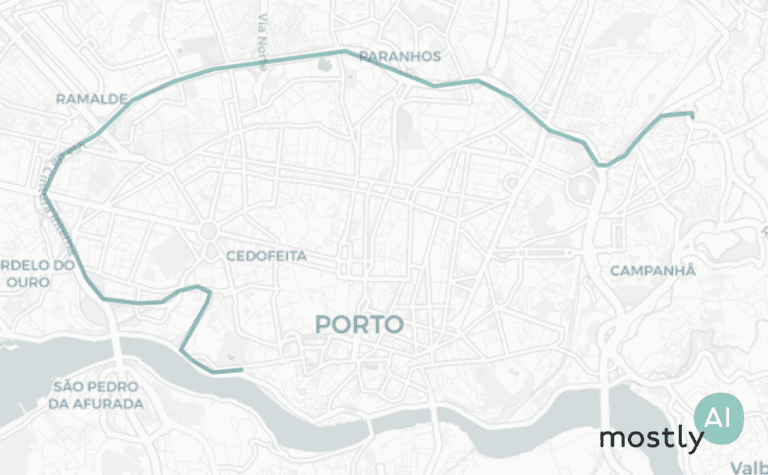
First, for a quick visual, we plotted 200 real trips recorded by real taxi drivers (on the left, in blue) and 200 of the artificial trajectories that our model generated (on the right, in green). As you can see, the overall picture is rather convincing with the high-level patterns nicely preserved.

Looking more closely, we see very similar noise in the real and synthetic trips on the street level.
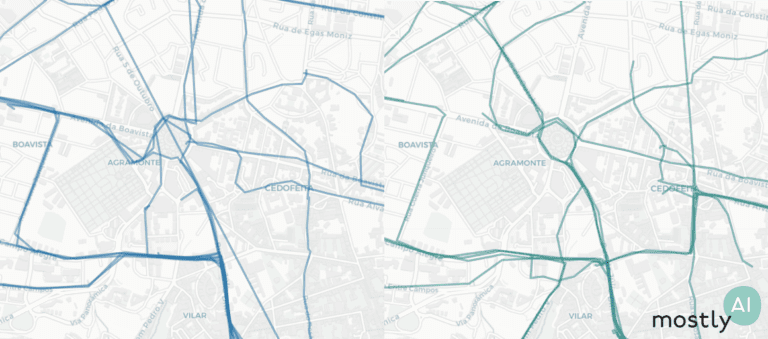
In general, we keep three main things in mind when evaluating synthetic data sets.
- Accuracy: How closely does the synthetic data follow the distribution of the real data set?
- Utility: Can we get competitive results using the synthetic data in downstream tasks?
- Privacy: Is it possible that we are disclosing some information about real individuals in our synthetic data?
As for accuracy, we compare the real and synthetic data across several location-and trip-level metrics. First, we require the model to accurately reproduce the location densities, the ratio of recordings at a given spatial area, and hot-spots at different granularity. There are plenty of open-source spatial analysis libraries that can help you work with location data such as skmob, geopandas, or Uber’s H3 which we used to generate the hexagonal plots below. The green-yellow-red transition marks how the city center is visited more frequently than the outskirts with a clear hot-spot in the red region.
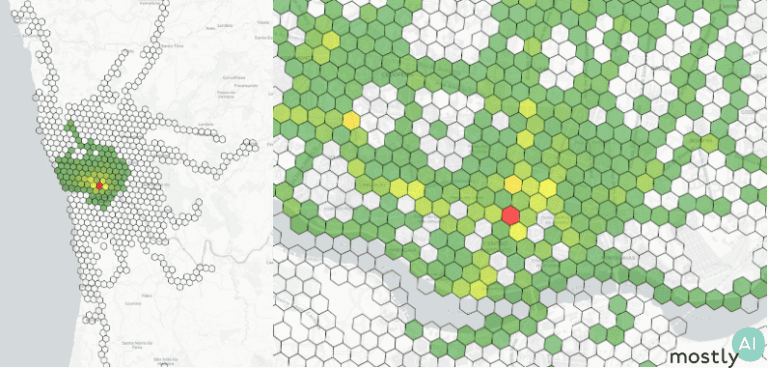
From the sequences of latitude and longitude coordinates, we derive various features such as trip duration and distance traveled, origin-destination distance, and a number of jump length statistics.
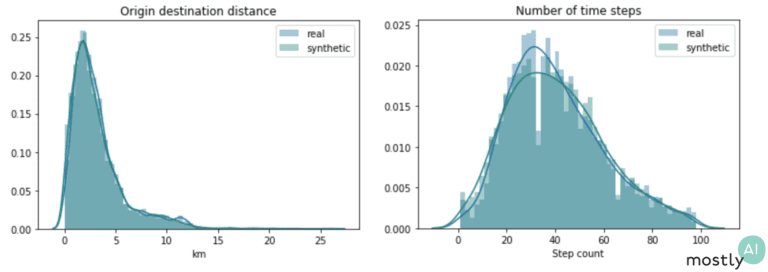
The plots above show two of these distributions both for the real and synthetic trips. The fact that these distributions overlap almost perfectly shows that our engine is spot-on at reproducing the hidden relationships in the data. To capture a different aspect of behavior, we also consider geometric properties of paths: the radius of gyration measures how far on average the trip is from its center of mass and the straightness index is the ratio of the origin-destination distance with the full traveled distance. So, for a straight line, the index is exactly 1 and for more curvy trips it takes lower values with a round trip corresponding to straightness index 0. We again see that the synthetic data follows the exact same trends as the real one, even mimicking the slight increase in the straightness distribution from 0.4 to 1. I should stress that we get this impressive performance without ever optimizing the model for these particular metrics and so we would expect similarly high accuracy for other so far untested features.
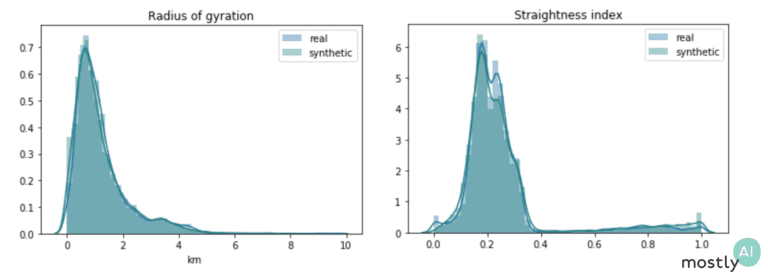
Regarding utility, one way we can test-drive our synthetic mobility data is to use it in practical machine learning scenarios. Here, we trained three models to predict the duration of a trip based on the origin and destination: a Support Vector Machine, a K-nearest neighbor regressor, and an LGBM regressor,
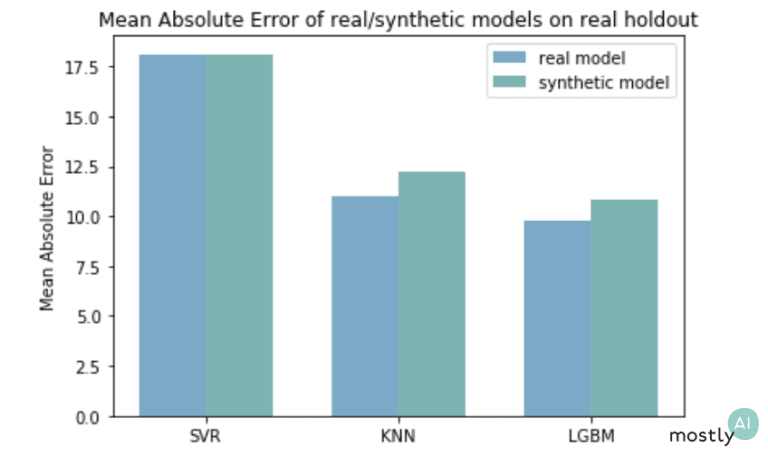
We trained the synthetic models only on synthetic data and the real models on the original trajectories. The scores in the plot came from testing all the models against a holdout from the original, real-life data set. As expected, the synthetically trained models performed slightly worse than the ones that have seen real data but still achieved a highly competitive performance.
Moreover, imagine you are an industry-leading company and shared the safe synthetic mobility data in a competition or hackathon to solve this prediction task. If the teams came up with the above-shown solutions and got the green error rates on the public, synthetic data then you can rightly infer that the winner solution would also do best on your real but sensitive data set that the teams have never seen.
The privacy evaluation of the generated data is always a critical and complicated issue. Already at the training phase, we have controls in place to stop the learning process and thus prevent overfitting. This ensures that the model is learning the general patterns in the data rather than memorizing exact trips or overly specific attributes of the training set. Second, we also compare how far our synthetic trips fall from the closest real trips in the training data. In the plot below, we have a single synthetic trip in red, with the purple trips being the three closest real trajectories, then the blue and green paths sampled from the 10-20th and 50-100th closest real trips.
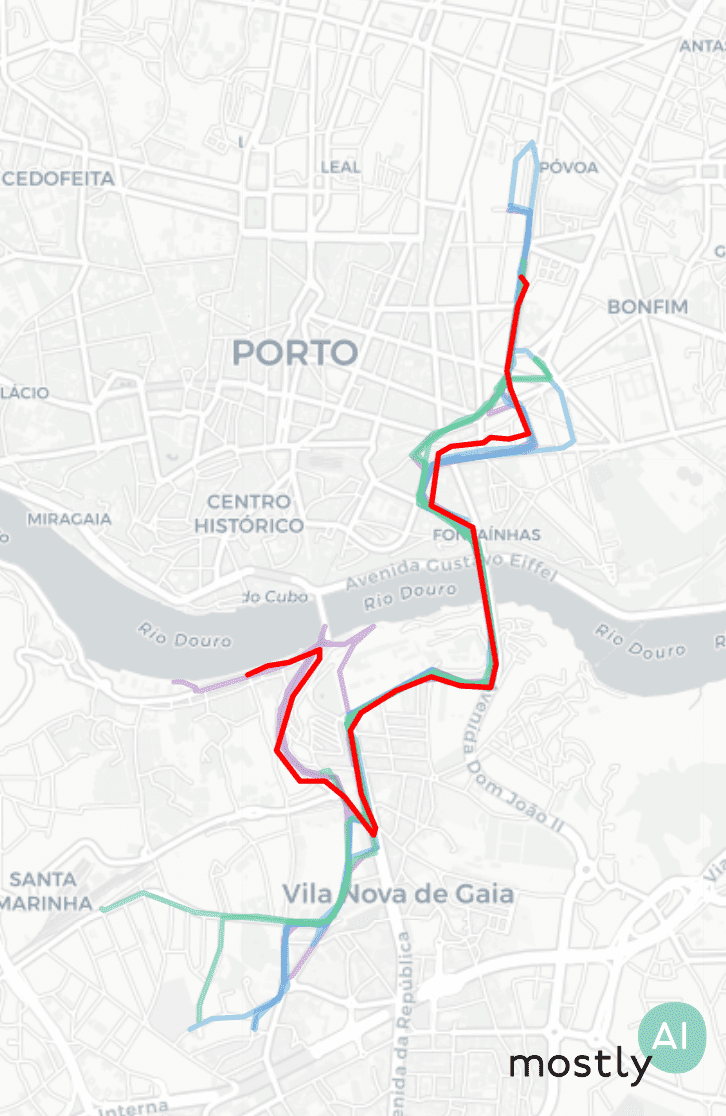
To quantify privacy, we actually look at the distribution of closest distances between real and synthetic trips. In order to have a baseline distribution, we repeat this calculation using a holdout of the original but so far unused trips instead of the synthetic ones. If these real-vs-synthetic and real-vs-holdout distributions differ heavily, in particular, if the synthetic data falls closer to the real samples than what we would expect based on the holdout, that could indicate an issue with the modeling. For example, if we simply add noise to real trajectories then the latter distributions will clearly flag this data set for a privacy leak. However, the data generated by our Mobility Engine passed these tests with flying colors.
Conclusions
We should be loud about not compromising on privacy, no matter the benefits offered by sharing our personal information. Governments, operators, service providers, and others alike need to take privacy seriously and invest in technology that protects the individual’s rights during the whole life cycle of the data. We at Mostly AI believe that synthetic data is THE way forward for privacy-preserving data sharing. Our new Mobility Engine allows organizations to fully utilize sensitive locational data by producing safe synthetic data at a so-far unseen level of accuracy.
Acknowledgment
This research and development on synthetic mobility data is supported by a grant of the Vienna Business Agency (Wirtschaftsagentur Wien), a fund of the City of Vienna.
